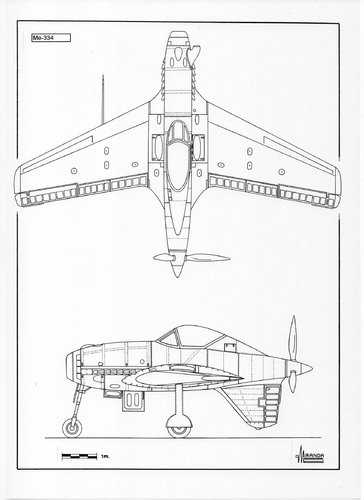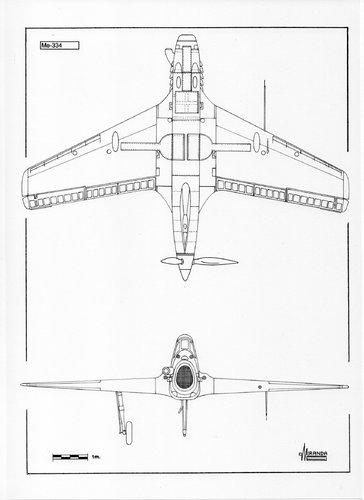Lippisch 8-334 (Me 334)
At the beginning of 1943 the OKL had serious doubts about the viability of the Me 163. To the various clashes occurred during flight tests, it has to be added the delay in the availability of the HWK RII-211 rocket engine, which first approved units for flying –still far from being safe- would not arrive at Peenemünde until July.
The Allies offensive of bombers increased everyday. Their escort fighters repelled the Bf 109 and Fw 190 and more devastating incursions were expected with the coming of good weather. The Me 262 did not seem to be the best solution. Its performance in dog fighting was not brilliant, its combat ceiling was insufficient, its engines were not safe and its airframe suffered of compressibility buffeting.
The Komet –which first 70 airframes were uselessly expecting their engines at Regensburg factory – was urgently needed in combat. The Abteilung L proposed the construction of two alternative version (Parallelenwürfe) in April. The first project was named Lippisch P.20, on 16 April 1943. Basically, it was a Me 163 with a Jumo 004 turbojet installed under the pilot, 36º swept wing and tricycle type undercarriage. The second project (Lippisch 8-334) never received the RLM official designation. Due to the strong personal disagreement between Lippisch and Messerschmit, Abteilung L was dissolved on 28 April and Lippisch himself left the company on 1 May.
The 8-334 was to be powered by a conventional 12 cylinder piston Daimler Benz DB 603 or 605 engines, located at the nose and driving a pusher propeller through an extension shaft.
Technical data Lippisch 8-334 (Me 334)
Type single seat interceptor fighter
Wings wooden structure, plywood cladding with 23.4º swept
Fuselage light alloy structure and cladding
Cockpit pressurised, control heating, frontal armour against 12.7 mm shelling and from the rear against 20 mm, Heinkel kartusche ejector seat
Tailfin light alloy structure and cladding with tail bumper
Undercarriage tricycle type, the main legs retractable inwards and the front gear retractable to the rear after switching 90º to fold under the engine
Engine a Daimler Benz DB 605 of 1,475 hp or a DB 603 of 1,900 hp, both twelve- cylinder, inverted V, liquid cooled engines, driving a 3 m diameter pusher propeller through an extension shaft
Fuel tank behind the pilot
Armament two MK 108/30 cannons in the wing roots and two MG 131/13 machine guns on top of the engine cowl
Electronics one EZ 42 gyrogunsight, FuG 16 Zy VHF transmitter/receivers, FuG 25a IFF radio set
Wingspan 9.3 m
Length 7 m
Height 3.72 m
Aspect ratio 5.0:1
Wing area 17.30 sq.m
Max. weight 3,000 kg
Max. speed (with DB 605) slightly better than a Me 109 G
Service ceiling (with DB 605) slightly better than a Me 109 G



